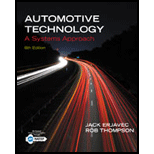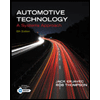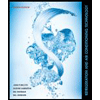
Automotive Technology: A Systems Approach (MindTap Course List)
6th Edition
ISBN: 9781133612315
Author: Jack Erjavec, Rob Thompson
Publisher: Cengage Learning
expand_more
expand_more
format_list_bulleted
Textbook Question
Chapter 10, Problem 12RQ
Which of the following is not considered part of the organic soil grouping?
- Petroleum by-products derived from crude oil, including tar, road oil, engine oil. gasoline, diesel fuel, grease, and engine oil additives
Expert Solution & Answer
Trending nowThis is a popular solution!

Students have asked these similar questions
Why these alternative materials can be used as household cleaning material.
Food stain on clothes: The alternative natural material can be used to clean the food chain on clothes are Talcum powder, Cornstarch and Chalk
Kitchen sink: The alternative natural material can be used to clean the kitchen sink are baking soda, salt and hot vinegar.
Bad smell/odor inside refrigerator: The alternative natural material can be used to clean the refrigerator are baking soda, vinegar, lemon, potatoes and active carbon
The presence of oxygen concentrations greater than 5 ppb in waterflood operations can cause severe corrosion and plugging of the formation by corrosion products. The three main processes can remove oxygen. Write a descriptive paragraph for each of the following process
Gas stripping
Chemical treatment
As the rank of the coal increases, the moisture content _________
a. increases
b. decreases
c. no direct change
Chapter 10 Solutions
Automotive Technology: A Systems Approach (MindTap Course List)
Ch. 10 - WHat should be worn when working with any type of...Ch. 10 - Prob. 2RQCh. 10 - What is the best way to lift a vehicle when...Ch. 10 - True or False? The first step in removing an...Ch. 10 - Prob. 5RQCh. 10 - The buildup of minerals and deposits inside the...Ch. 10 - Hydrocarbon solvents are. flammable toxic both a...Ch. 10 - Prob. 8RQCh. 10 - Which cleaning method uses high-frequency sound...Ch. 10 - Parts must be when they go into an abrasive blast...
Ch. 10 - Prob. 11RQCh. 10 - Which of the following is not considered part of...Ch. 10 - Why should a memory saver be installed before dis...Ch. 10 - Which of the following statements is not true...Ch. 10 - Which of the following is not a common way to...Ch. 10 - While working on an engine with an excessive...Ch. 10 - While discussing the common causes for cracks...Ch. 10 - Technician A uses a crane to remove an engine from...Ch. 10 - Prob. 4ASRQCh. 10 - While discussing abrasive cleaners: Technician A...Ch. 10 - Technician A labels or marks all electrical wires...Ch. 10 - While discussing cleaning engine parts: Technician...Ch. 10 - While loosening the axle shaft hub nuts on a FWD...Ch. 10 - While preparing to remove an engine: Technician A...Ch. 10 - After removing the vehicles hood in preparation...
Knowledge Booster
Learn more about
Need a deep-dive on the concept behind this application? Look no further. Learn more about this topic, mechanical-engineering and related others by exploring similar questions and additional content below.Similar questions
- The component that changes the molecular structure of hydrocarbons into hydrogen-rich gas is called a. a. pressure container b. fuel cell c. fuel injector d. reformerarrow_forwardWhich cleaning method uses high-frequency sound waves to create microscopic bubbles that loosen dirt from parts? Ultrasonic Salt bath Thermal Causticarrow_forwardWhich is not a common automotive fuel? Gasoline Diesel Hydrogen Ethanolarrow_forward
- Technician A says that the volatility of a substance is a statement of how easily the substance vaporizes or explodes. Technician B says that the flammability of a substance is a statement of how well the substance supports combustion. Who is correct? Technician A Technician B Both A and B Neither A nor Barrow_forwardWhat is the correct way to dispose of used oil filters?arrow_forwardProper disposal of oil filters includes. recycling used filters draining them for at least 24 hours crushing them all of the abovearrow_forward
- The most common fuel oil used for residential and light commercial is A.Number 1. B. Number 2. C. Number 3. D. Number 4.arrow_forwardWhich of the following is not recommended for use when trying to extinguish flammable liquid fires? Foam Carbon dioxide Water Dry chemicalarrow_forwardIn addition to HC and NOx, which of the following is needed to form smog? sunlight O2 high temperatures COarrow_forward
arrow_back_ios
SEE MORE QUESTIONS
arrow_forward_ios
Recommended textbooks for you
 Automotive Technology: A Systems Approach (MindTa...Mechanical EngineeringISBN:9781133612315Author:Jack Erjavec, Rob ThompsonPublisher:Cengage Learning
Automotive Technology: A Systems Approach (MindTa...Mechanical EngineeringISBN:9781133612315Author:Jack Erjavec, Rob ThompsonPublisher:Cengage Learning Refrigeration and Air Conditioning Technology (Mi...Mechanical EngineeringISBN:9781305578296Author:John Tomczyk, Eugene Silberstein, Bill Whitman, Bill JohnsonPublisher:Cengage Learning
Refrigeration and Air Conditioning Technology (Mi...Mechanical EngineeringISBN:9781305578296Author:John Tomczyk, Eugene Silberstein, Bill Whitman, Bill JohnsonPublisher:Cengage Learning

Automotive Technology: A Systems Approach (MindTa...
Mechanical Engineering
ISBN:9781133612315
Author:Jack Erjavec, Rob Thompson
Publisher:Cengage Learning

Refrigeration and Air Conditioning Technology (Mi...
Mechanical Engineering
ISBN:9781305578296
Author:John Tomczyk, Eugene Silberstein, Bill Whitman, Bill Johnson
Publisher:Cengage Learning
Extent of Reaction; Author: LearnChemE;https://www.youtube.com/watch?v=__stMf3OLP4;License: Standard Youtube License